engine MITSUBISHI LANCER EVOLUTION IX 2005 Repair Manual
[x] Cancel search | Manufacturer: MITSUBISHI, Model Year: 2005, Model line: LANCER EVOLUTION IX, Model: MITSUBISHI LANCER EVOLUTION IX 2005Pages: 364, PDF Size: 14.38 MB
Page 58 of 364
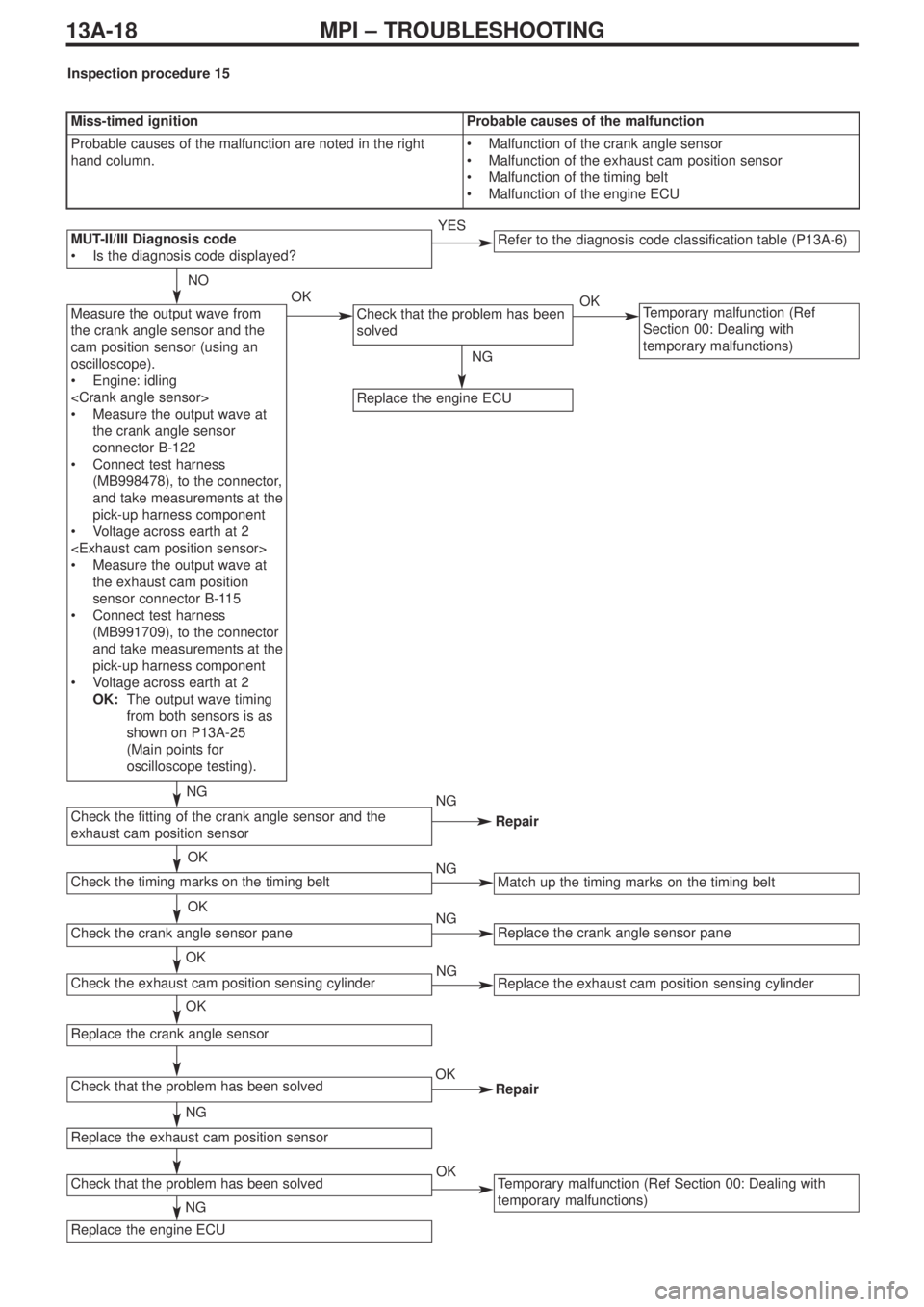
13A-18MPI – TROUBLESHOOTING
Measure the output wave from
the crank angle sensor and the
cam position sensor (using an
oscilloscope).
•Engine: idling
•Measure the output wave at
the crank angle sensor
connector B-122
•Connect test harness
(MB998478), to the connector,
and take measurements at the
pick-up harness component
•Voltage across earth at 2
•Measure the output wave at
the exhaust cam position
sensor connector B-115
•Connect test harness
(MB991709), to the connector
and take measurements at the
pick-up harness component
•Voltage across earth at 2
OK:The output wave timing
from both sensors is as
shown on P13A-25
(Main points for
oscilloscope testing).Check that the problem has been
solvedTemporary malfunction (Ref
Section 00: Dealing with
temporary malfunctions)
Replace the engine ECU
NO
OK
NG
OK
NG
NG
NG
Repair
Miss-timed ignitionProbable causes of the malfunction
Probable causes of the malfunction are noted in the right
hand column.•Malfunction of the crank angle sensor
•Malfunction of the exhaust cam position sensor
•Malfunction of the timing belt
•Malfunction of the engine ECU
Inspection procedure 15
Refer to the diagnosis code classification table (P13A-6)MUT-II/III Diagnosis code
•Is the diagnosis code displayed?YES
Repair
Replace the crank angle sensor pane
Match up the timing marks on the timing belt
Replace the exhaust cam position sensing cylinder
Temporary malfunction (Ref Section 00: Dealing with
temporary malfunctions)
Check the exhaust cam position sensing cylinder
Check the fitting of the crank angle sensor and the
exhaust cam position sensor
Check the timing marks on the timing belt
Check the crank angle sensor pane
Replace the crank angle sensor
Check that the problem has been solved
Replace the exhaust cam position sensor
Check that the problem has been solved
Replace the engine ECU
OK
OK
OK
NG
OK
NG
NG
NG
OK
OK
Page 59 of 364
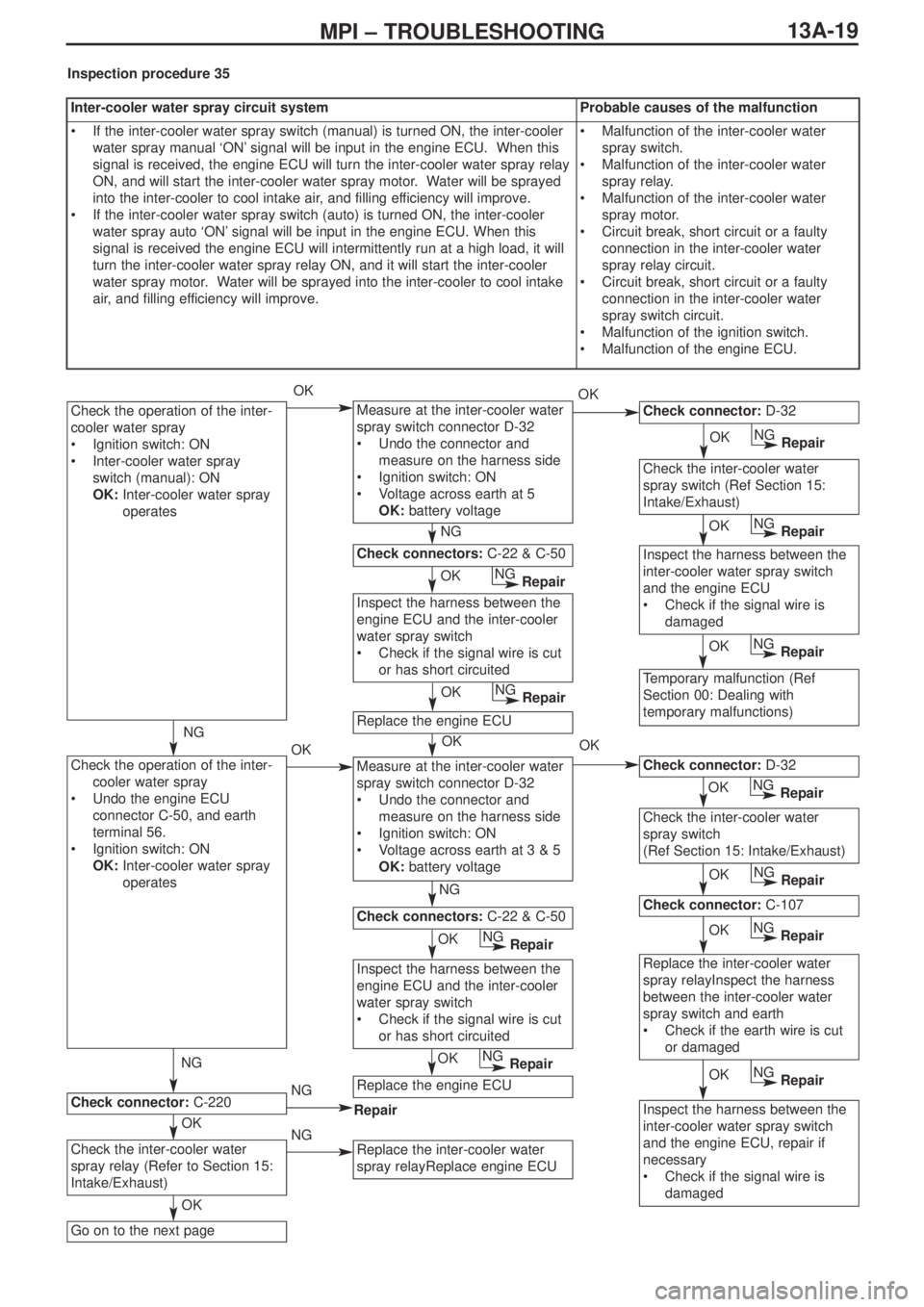
13A-19MPI – TROUBLESHOOTING
Check the operation of the inter-
cooler water spray
•Ignition switch: ON
•Inter-cooler water spray
switch (manual): ON
OK:Inter-cooler water spray
operates
Check the operation of the inter-
cooler water spray
•Undo the engine ECU
connector C-50, and earth
terminal 56.
•Ignition switch: ON
OK:Inter-cooler water spray
operates
Check connector:C-220
Check the inter-cooler water
spray relay (Refer to Section 15:
Intake/Exhaust)
Go on to the next page
Measure at the inter-cooler water
spray switch connector D-32
•Undo the connector and
measure on the harness side
•Ignition switch: ON
•Voltage across earth at 5
OK:battery voltage
Check connectors: C-22 & C-50
Check connector: D-32
Inspect the harness between the
engine ECU and the inter-cooler
water spray switch
•Check if the signal wire is cut
or has short circuited
Replace the engine ECU
Check connectors: C-22 & C-50
Measure at the inter-cooler water
spray switch connector D-32
•Undo the connector and
measure on the harness side
•Ignition switch: ON
•Voltage across earth at 3 & 5
OK:battery voltage
Replace the inter-cooler water
spray relayReplace engine ECU
Check the inter-cooler water
spray switch (Ref Section 15:
Intake/Exhaust)
Inspect the harness between the
inter-cooler water spray switch
and the engine ECU
•Check if the signal wire is
damaged
Temporary malfunction (Ref
Section 00: Dealing with
temporary malfunctions)
Check connector:D-32
Check the inter-cooler water
spray switch
(Ref Section 15: Intake/Exhaust)
Check connector:C-107
Replace the inter-cooler water
spray relayInspect the harness
between the inter-cooler water
spray switch and earth
•Check if the earth wire is cut
or damaged
Inspect the harness between the
inter-cooler water spray switch
and the engine ECU, repair if
necessary
•Check if the signal wire is
damaged
Inspect the harness between the
engine ECU and the inter-cooler
water spray switch
•Check if the signal wire is cut
or has short circuited
OK
NG
NG
OK
NG
NG
OK
OK
OK
OK
NG
OK
OK
NG
NG
Repair
Inspection procedure 35
Inter-cooler water spray circuit systemProbable causes of the malfunction
•If the inter-cooler water spray switch (manual) is turned ON, the inter-cooler
water spray manual ‘ON’ signal will be input in the engine ECU. When this
signal is received, the engine ECU will turn the inter-cooler water spray relay
ON, and will start the inter-cooler water spray motor. Water will be sprayed
into the inter-cooler to cool intake air, and filling efficiency will improve.
•If the inter-cooler water spray switch (auto) is turned ON, the inter-cooler
water spray auto ‘ON’ signal will be input in the engine ECU. When this
signal is received the engine ECU will intermittently run at a high load, it will
turn the inter-cooler water spray relay ON, and it will start the inter-cooler
water spray motor. Water will be sprayed into the inter-cooler to cool intake
air, and filling efficiency will improve.•Malfunction of the inter-cooler water
spray switch.
•Malfunction of the inter-cooler water
spray relay.
•Malfunction of the inter-cooler water
spray motor.
•Circuit break, short circuit or a faulty
connection in the inter-cooler water
spray relay circuit.
•Circuit break, short circuit or a faulty
connection in the inter-cooler water
spray switch circuit.
•Malfunction of the ignition switch.
•Malfunction of the engine ECU.
Replace the engine ECU
OKNGRepair
OKNGRepair
OKNGRepair
OKNGRepair
OKNGRepair
OKNGRepair
OKNGRepair
OKNGRepair
OKNGRepair
OKNGRepair
Repair
Page 60 of 364
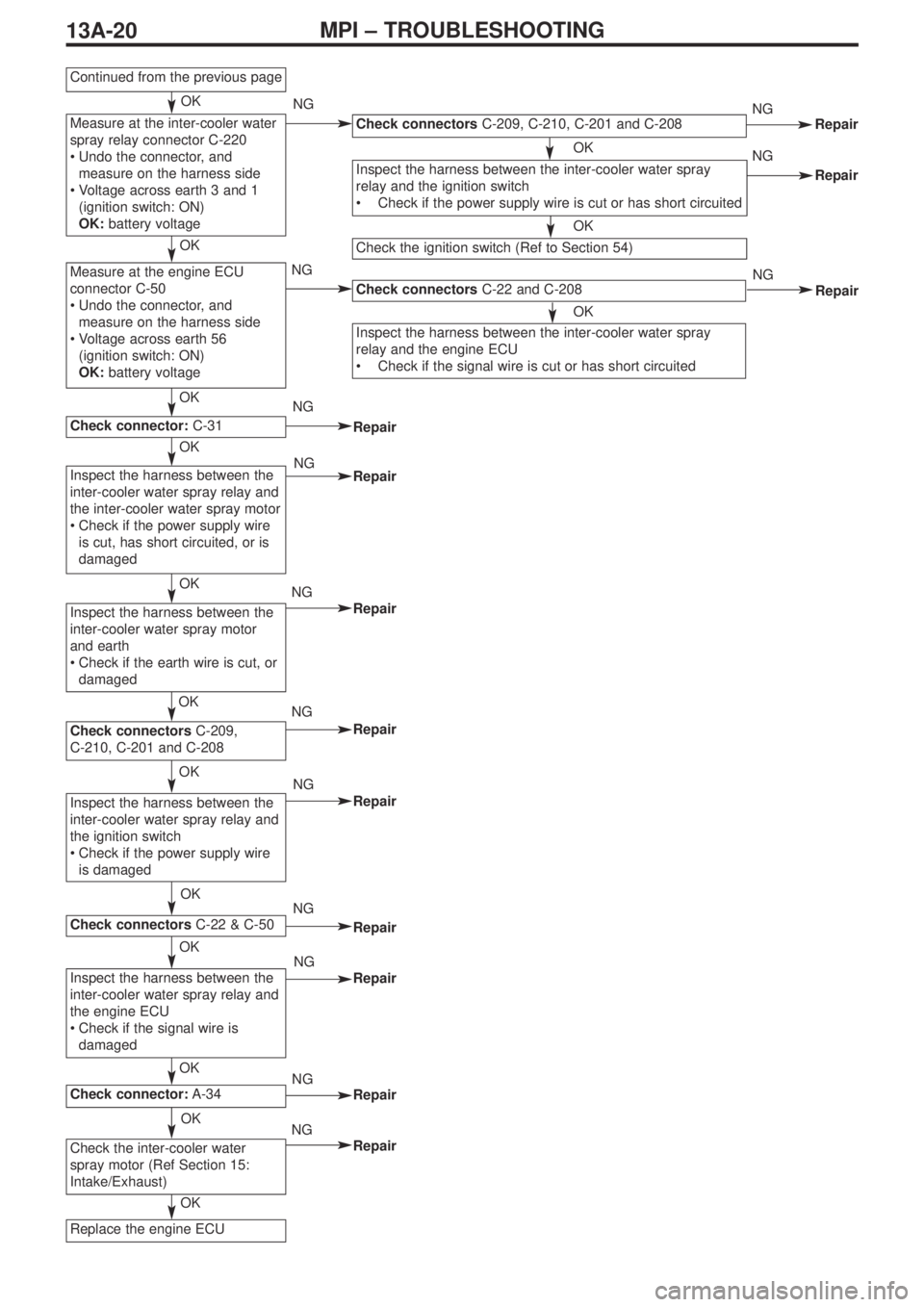
13A-20MPI – TROUBLESHOOTING
Measure at the inter-cooler water
spray relay connector C-220
•Undo the connector, and
measure on the harness side
•Voltage across earth 3 and 1
(ignition switch: ON)
OK:battery voltage
Measure at the engine ECU
connector C-50
•Undo the connector, and
measure on the harness side
•Voltage across earth 56
(ignition switch: ON)
OK:battery voltage
Check connector:C-31
Inspect the harness between the
inter-cooler water spray relay and
the inter-cooler water spray motor
•Check if the power supply wire
is cut, has short circuited, or is
damaged
Inspect the harness between the
inter-cooler water spray motor
and earth
•Check if the earth wire is cut, or
damaged
Check connectors C-209,
C-210, C-201 and C-208
Inspect the harness between the
inter-cooler water spray relay and
the ignition switch
•Check if the power supply wire
is damaged
Check connectors C-22 & C-50
Inspect the harness between the
inter-cooler water spray relay and
the engine ECU
•Check if the signal wire is
damaged
Check connector:A-34
Replace the engine ECU
Check the inter-cooler water
spray motor (Ref Section 15:
Intake/Exhaust)
Check connectorsC-209, C-210, C-201 and C-208
Inspect the harness between the inter-cooler water spray
relay and the ignition switch
•Check if the power supply wire is cut or has short circuited
Continued from the previous page
Check the ignition switch (Ref to Section 54)
Check connectorsC-22 and C-208
Inspect the harness between the inter-cooler water spray
relay and the engine ECU
•Check if the signal wire is cut or has short circuited
OK
OK
OK
OK
OK
OK
OK
OK
OK
OK
OK
OK
OK
OK
OK
NGNG
NG
NGNG
NG
NG
NG
NG
NG
NG
NG
NG
NG
Repair
Repair
Repair
Repair
Repair
Repair
Repair
Repair
Repair
Repair
Repair
Repair
Page 61 of 364
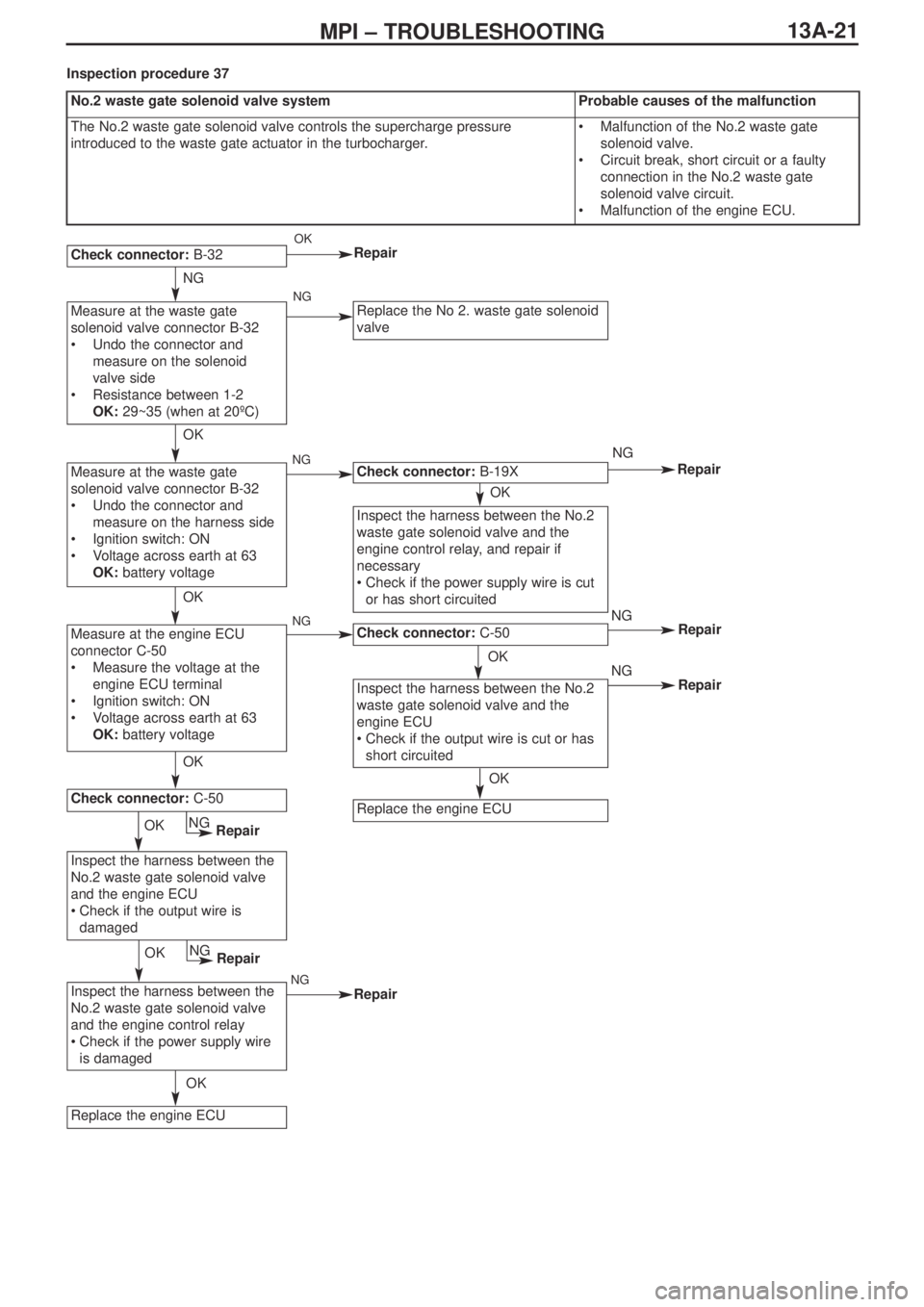
13A-21MPI – TROUBLESHOOTING
Check connector: B-32
Replace the No 2. waste gate solenoid
valve
Check connector:B-19X
Measure at the waste gate
solenoid valve connector B-32
•Undo the connector and
measure on the solenoid
valve side
•Resistance between 1-2
OK:29~35Ω(when at 20ºC)
Measure at the waste gate
solenoid valve connector B-32
•Undo the connector and
measure on the harness side
•Ignition switch: ON
•Voltage across earth at 63
OK:battery voltage
Measure at the engine ECU
connector C-50
•Measure the voltage at the
engine ECU terminal
•Ignition switch: ON
•Voltage across earth at 63
OK:battery voltage
Check connector:C-50
Inspect the harness between the
No.2 waste gate solenoid valve
and the engine ECU
•Check if the output wire is
damaged
Inspect the harness between the
No.2 waste gate solenoid valve
and the engine control relay
•Check if the power supply wire
is damaged
Replace the engine ECU
Inspect the harness between the No.2
waste gate solenoid valve and the
engine control relay, and repair if
necessary
•Check if the power supply wire is cut
or has short circuited
Check connector:C-50
Inspect the harness between the No.2
waste gate solenoid valve and the
engine ECU
•Check if the output wire is cut or has
short circuited
Replace the engine ECU
NG
OK
OK
OK
OK
OK
NG
NG
NG
NG
Repair
Repair
OK
OK
NG
NG
OK
Repair
NGRepair
Repair
No.2 waste gate solenoid valve systemProbable causes of the malfunction
The No.2 waste gate solenoid valve controls the supercharge pressure
introduced to the waste gate actuator in the turbocharger.•Malfunction of the No.2 waste gate
solenoid valve.
•Circuit break, short circuit or a faulty
connection in the No.2 waste gate
solenoid valve circuit.
•Malfunction of the engine ECU.
OKNGRepair
OKNGRepair
Inspection procedure 37
Page 62 of 364
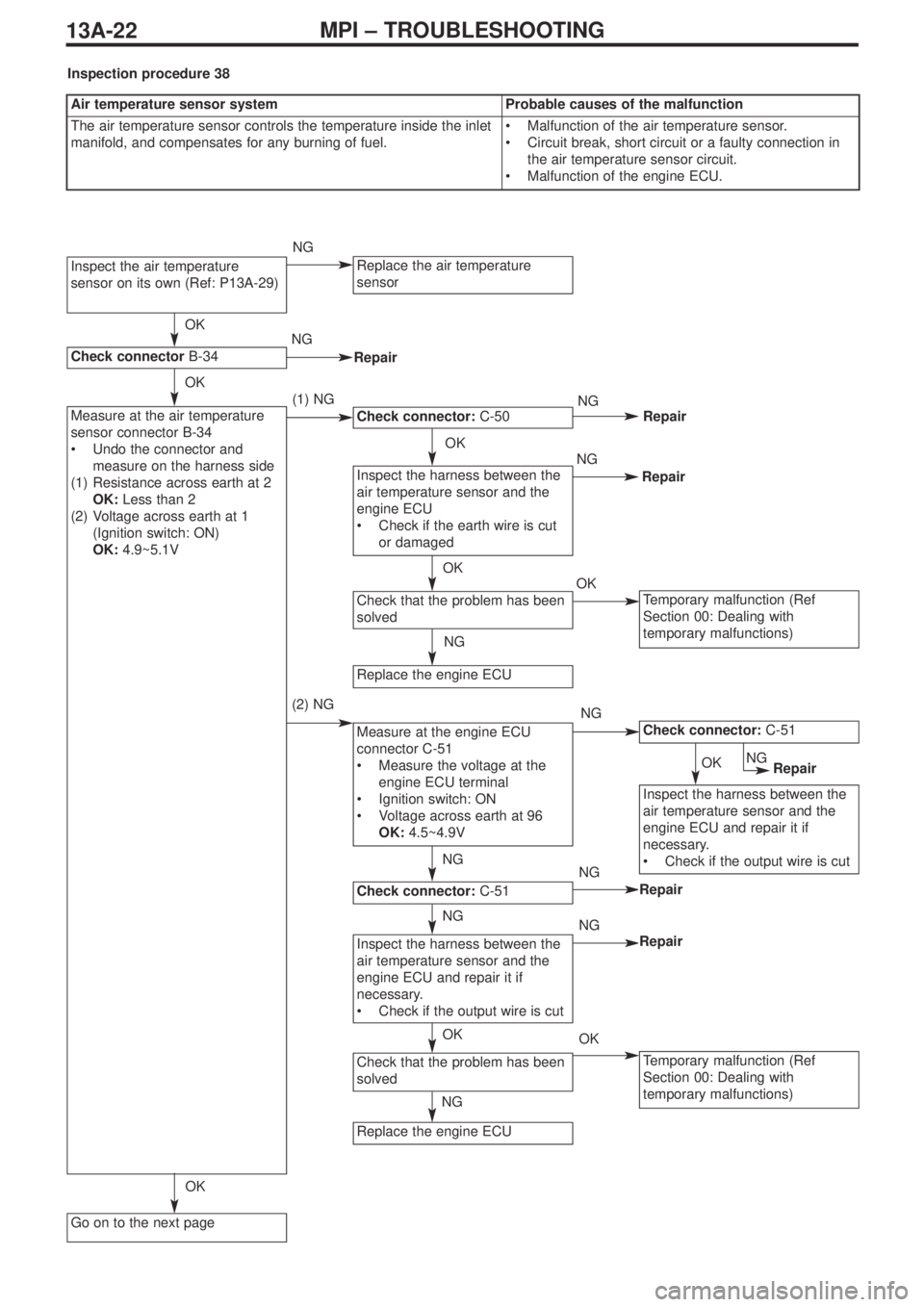
13A-22MPI – TROUBLESHOOTING
Inspect the air temperature
sensor on its own (Ref: P13A-29)
Check connectorB-34
Measure at the air temperature
sensor connector B-34
•Undo the connector and
measure on the harness side
(1) Resistance across earth at 2
OK:Less than 2Ω
(2) Voltage across earth at 1
(Ignition switch: ON)
OK:4.9~5.1V
Go on to the next page
Replace the air temperature
sensor
Temporary malfunction (Ref
Section 00: Dealing with
temporary malfunctions)
Measure at the engine ECU
connector C-51
•Measure the voltage at the
engine ECU terminal
•Ignition switch: ON
•Voltage across earth at 96
OK:4.5~4.9V
Replace the engine ECU
Check that the problem has been
solved
Inspect the harness between the
air temperature sensor and the
engine ECU
•Check if the earth wire is cut
or damaged
Check connector:C-50
Inspect the harness between the
air temperature sensor and the
engine ECU and repair it if
necessary.
•Check if the output wire is cut
Check connector:C-51
Temporary malfunction (Ref
Section 00: Dealing with
temporary malfunctions)
Check connector:C-51
Check that the problem has been
solved
Replace the engine ECU
Inspect the harness between the
air temperature sensor and the
engine ECU and repair it if
necessary.
•Check if the output wire is cut
OKNG
(1) NG
(2) NG
NG
OK
OK
NG
NG
NG
OK
NG
OK
OK
OK
NG
NG
NG
NG
NG
OK
Repair
Repair
Repair
Repair
Repair
Air temperature sensor systemProbable causes of the malfunction
The air temperature sensor controls the temperature inside the inlet
manifold, and compensates for any burning of fuel.•Malfunction of the air temperature sensor.
•Circuit break, short circuit or a faulty connection in
the air temperature sensor circuit.
•Malfunction of the engine ECU.
Inspection procedure 38
OKNGRepair
Page 63 of 364
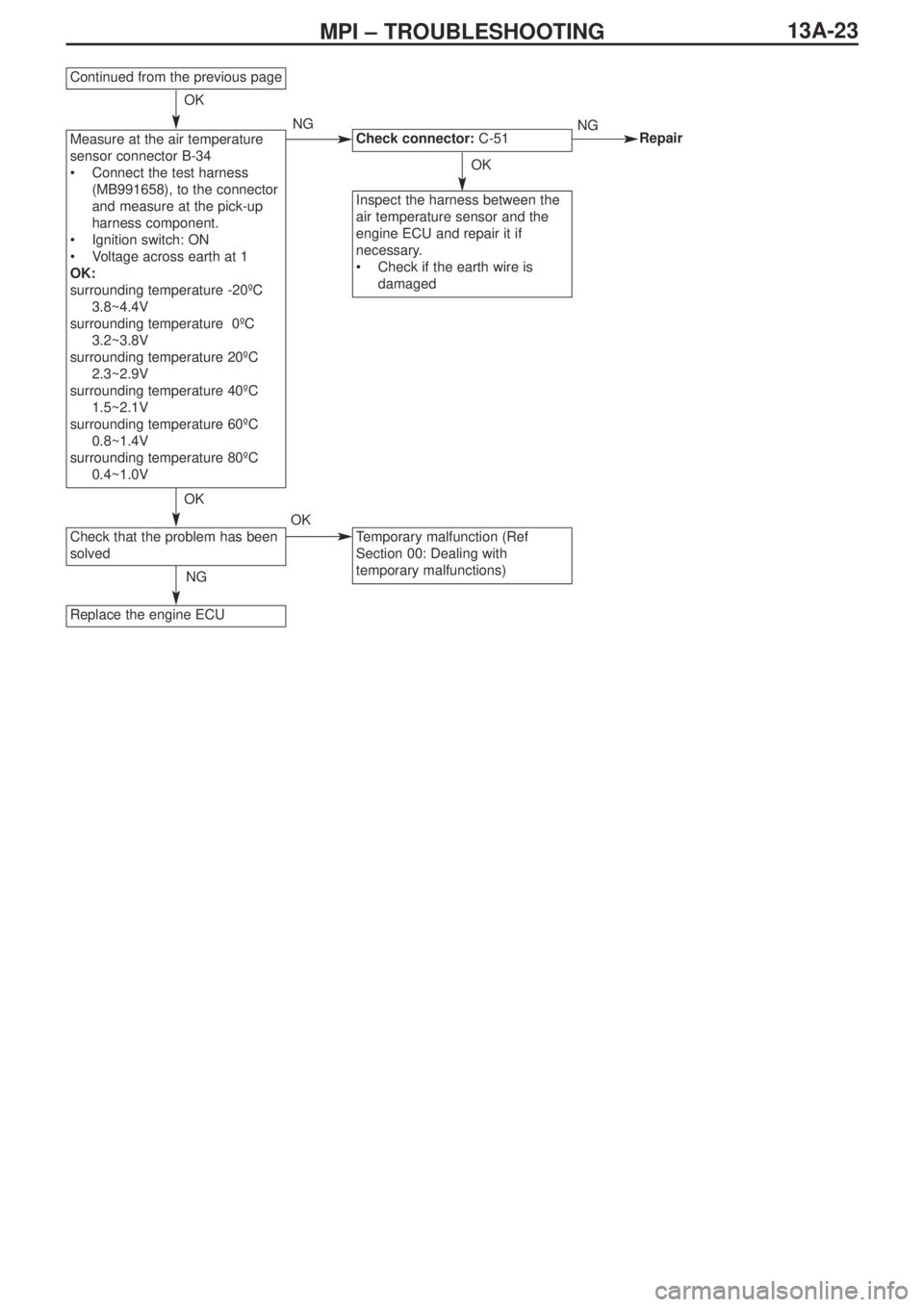
13A-23MPI – TROUBLESHOOTING
Continued from the previous page
Measure at the air temperature
sensor connector B-34
•Connect the test harness
(MB991658), to the connector
and measure at the pick-up
harness component.
•Ignition switch: ON
•Voltage across earth at 1
OK:
surrounding temperature -20ºC
3.8~4.4V
surrounding temperature 0ºC
3.2~3.8V
surrounding temperature 20ºC
2.3~2.9V
surrounding temperature 40ºC
1.5~2.1V
surrounding temperature 60ºC
0.8~1.4V
surrounding temperature 80ºC
0.4~1.0V
Check that the problem has been
solved
Replace the engine ECU
Inspect the harness between the
air temperature sensor and the
engine ECU and repair it if
necessary.
•Check if the earth wire is
damaged
Check connector: C-51
Temporary malfunction (Ref
Section 00: Dealing with
temporary malfunctions)
OK
OK
OK
NG
NG
OK
NGRepair
Page 64 of 364
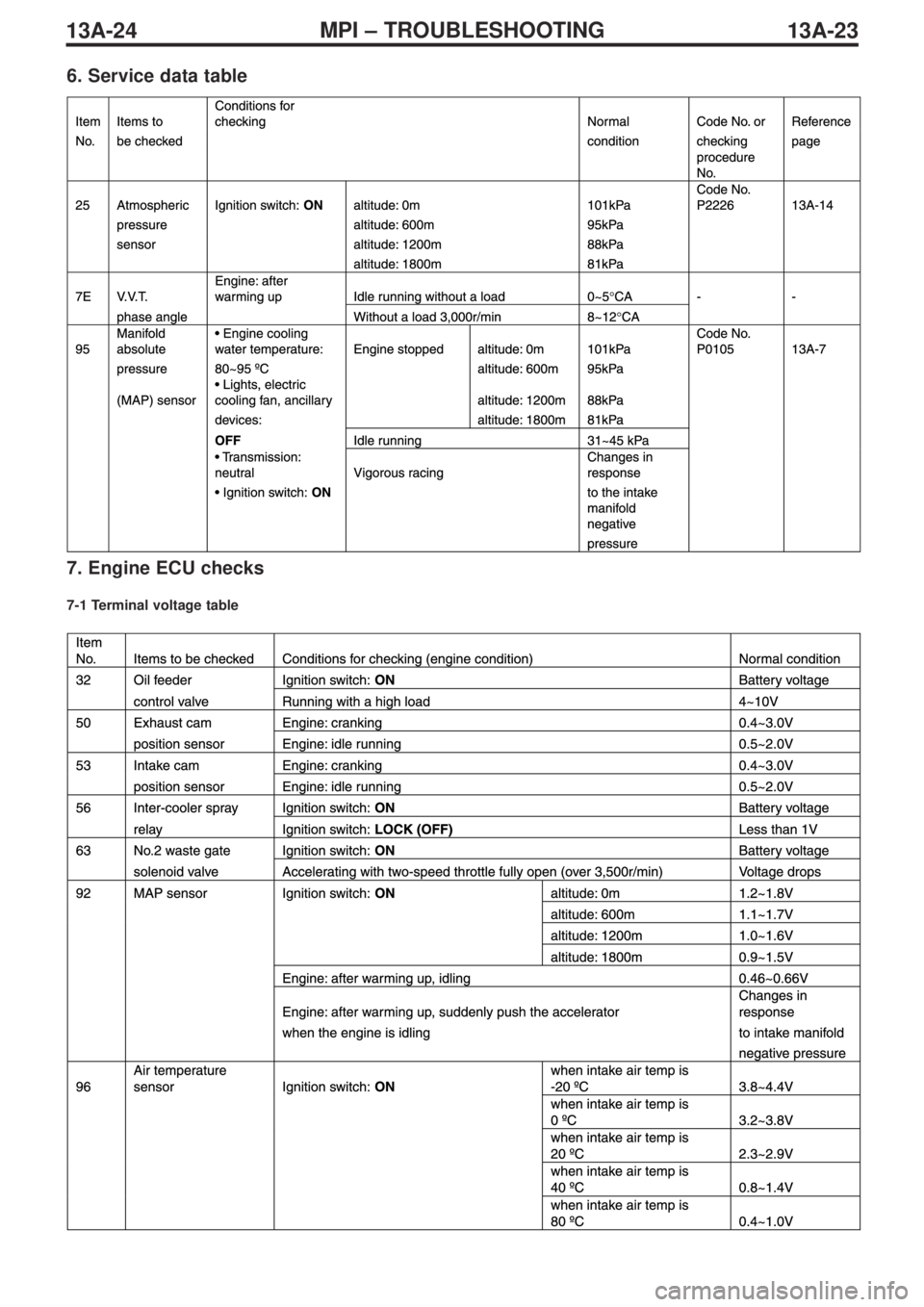
13A-24MPI – TROUBLESHOOTING
13A-23
6. Service data table
7. Engine ECU checks
7-1 Terminal voltage table
Page 65 of 364
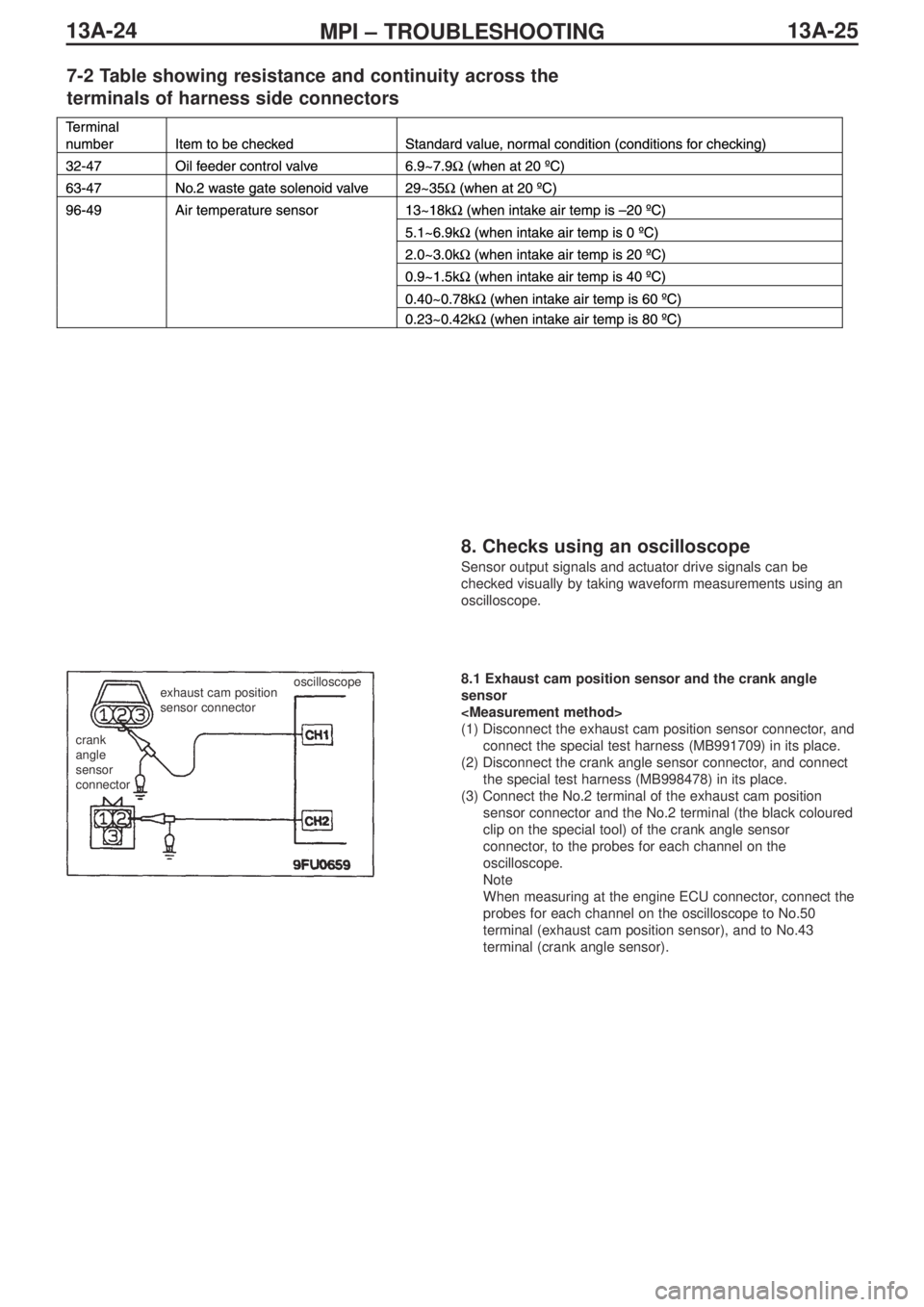
13A-25MPI – TROUBLESHOOTING 13A-24
7-2 Table showing resistance and continuity across the
terminals of harness side connectors
8. Checks using an oscilloscope
Sensor output signals and actuator drive signals can be
checked visually by taking waveform measurements using an
oscilloscope.
crank
angle
sensor
connectorexhaust cam position
sensor connector
oscilloscope8.1 Exhaust cam position sensor and the crank angle
sensor
(1) Disconnect the exhaust cam position sensor connector, and
connect the special test harness (MB991709) in its place.
(2) Disconnect the crank angle sensor connector, and connect
the special test harness (MB998478) in its place.
(3) Connect the No.2 terminal of the exhaust cam position
sensor connector and the No.2 terminal (the black coloured
clip on the special tool) of the crank angle sensor
connector, to the probes for each channel on the
oscilloscope.
Note
When measuring at the engine ECU connector, connect the
probes for each channel on the oscilloscope to No.50
terminal (exhaust cam position sensor), and to No.43
terminal (crank angle sensor).
Page 66 of 364
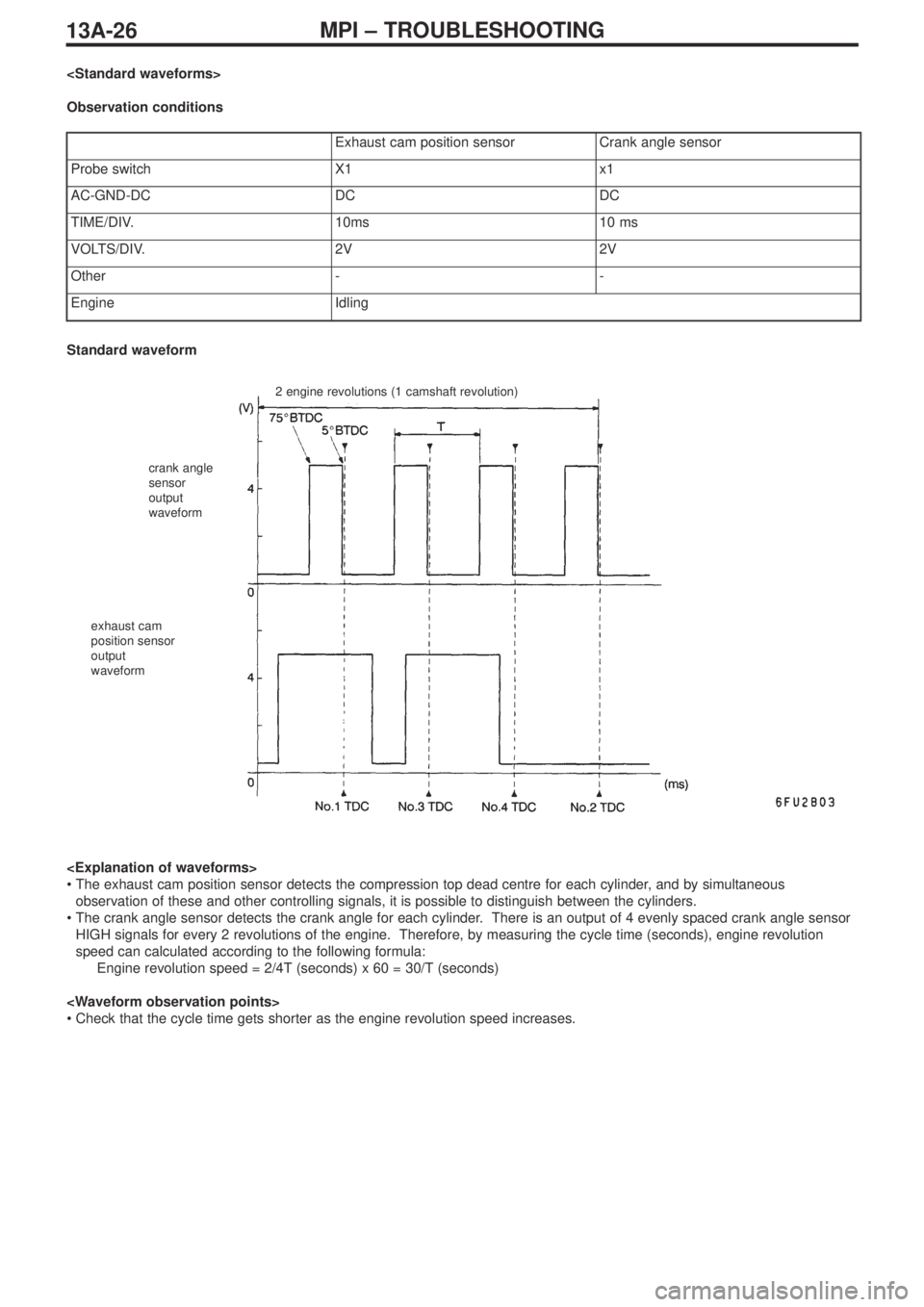
13A-26MPI – TROUBLESHOOTING
Observation conditions
Exhaust cam position sensorCrank angle sensor
Probe switchX1x1
AC-GND-DCDCDC
TIME/DIV.10ms10 ms
VOLTS/DIV.2V2V
Other--
EngineIdling
2 engine revolutions (1 camshaft revolution)
crank angle
sensor
output
waveform
exhaust cam
position sensor
output
waveform
Standard waveform
•The exhaust cam position sensor detects the compression top dead centre for each cylinder, and by simultaneous
observation of these and other controlling signals, it is possible to distinguish between the cylinders.
•The crank angle sensor detects the crank angle for each cylinder. There is an output of 4 evenly spaced crank angle sensor
HIGH signals for every 2 revolutions of the engine. Therefore, by measuring the cycle time (seconds), engine revolution
speed can calculated according to the following formula:
Engine revolution speed = 2/4T (seconds) x 60 = 30/T (seconds)
•Check that the cycle time gets shorter as the engine revolution speed increases.
Page 67 of 364
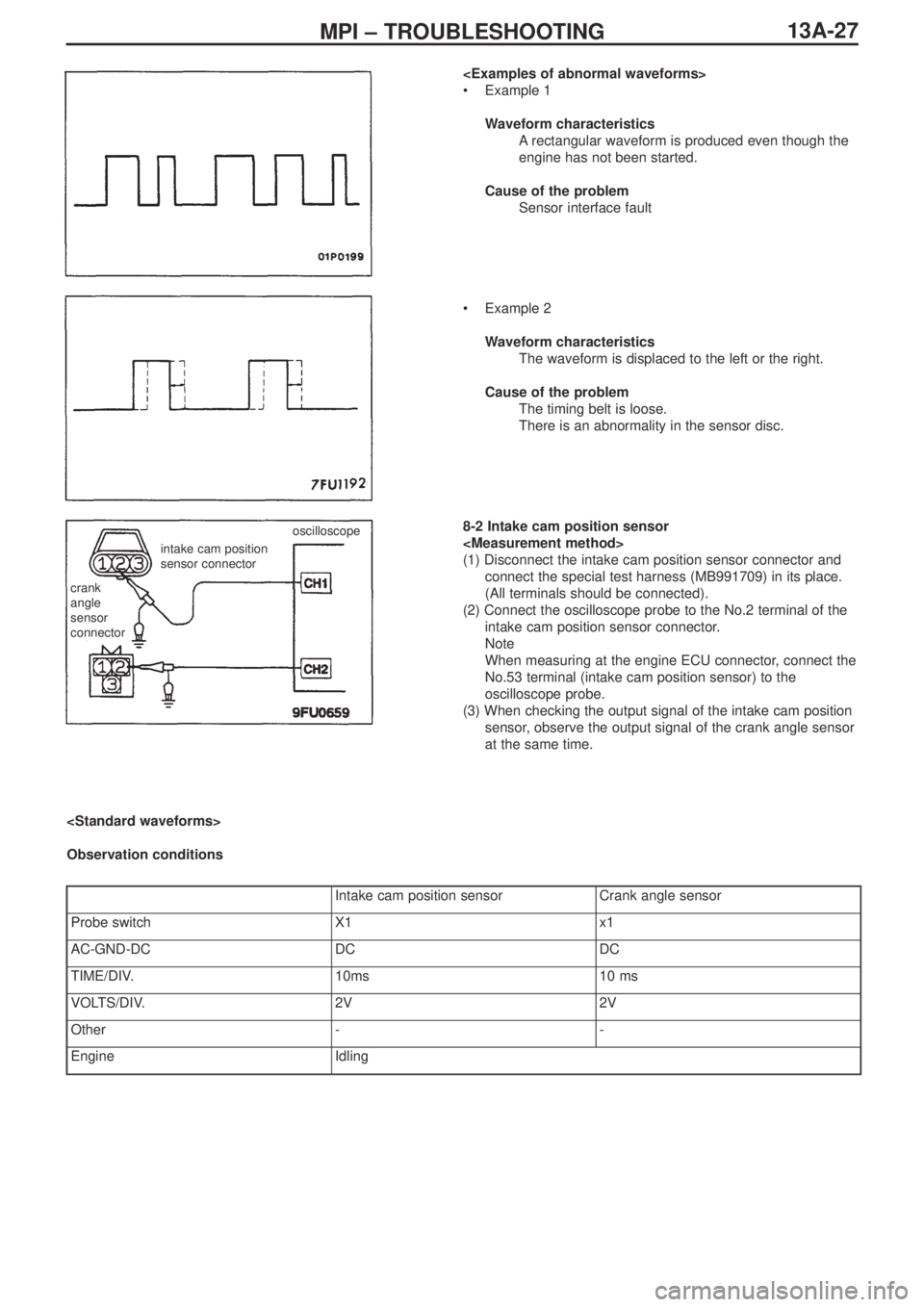
13A-27MPI – TROUBLESHOOTING
•Example 1
Waveform characteristics
Arectangular waveform is produced even though the
engine has not been started.
Cause of the problem
Sensor interface fault
•Example 2
Waveform characteristics
The waveform is displaced to the left or the right.
Cause of the problem
The timing belt is loose.
There is an abnormality in the sensor disc.
8-2 Intake cam position sensor
(1) Disconnect the intake cam position sensor connector and
connect the special test harness (MB991709) in its place.
(All terminals should be connected).
(2) Connect the oscilloscope probe to the No.2 terminal of the
intake cam position sensor connector.
Note
When measuring at the engine ECU connector, connect the
No.53 terminal (intake cam position sensor) to the
oscilloscope probe.
(3) When checking the output signal of the intake cam position
sensor, observe the output signal of the crank angle sensor
at the same time.
crank
angle
sensor
connector
intake cam position
sensor connectoroscilloscope
Observation conditions
Intake cam position sensorCrank angle sensor
Probe switchX1x1
AC-GND-DCDCDC
TIME/DIV.10ms10 ms
VOLTS/DIV.2V2V
Other--
EngineIdling